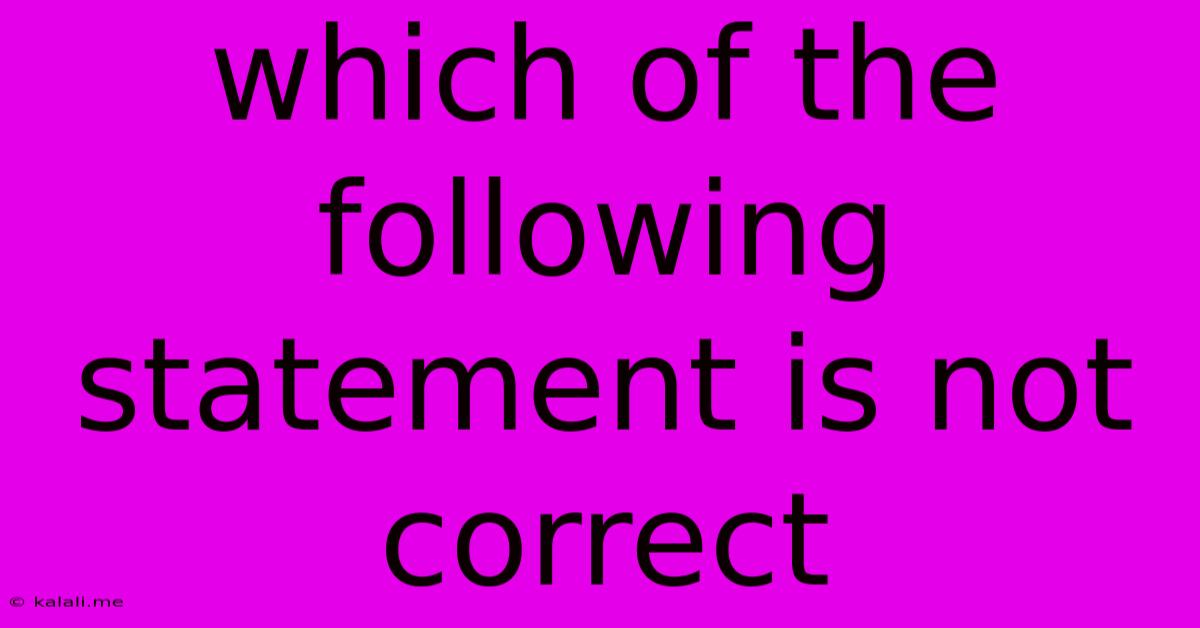Which Of The Following Statement Is Not Correct
Kalali
Jun 15, 2025 · 3 min read

Table of Contents
Which of the Following Statements is NOT Correct? A Guide to Identifying Falsehoods
Determining which statement is incorrect among a group requires critical thinking and careful analysis. This skill is vital in various aspects of life, from academic assessments to everyday decision-making. This article will explore strategies to effectively identify false statements, focusing on the critical elements to consider. This guide will help you confidently navigate situations where you need to pinpoint inaccuracies.
Identifying the incorrect statement involves understanding the context, analyzing the evidence, and recognizing logical fallacies. Let's delve into effective techniques.
Understanding the Context: The Foundation of Accurate Judgement
Before diving into the statements themselves, understanding the context is crucial. What is the subject matter? What are the underlying assumptions? Context provides a framework for evaluating the truthfulness of each statement. For example, a statement that might be true in one historical period might be demonstrably false in another.
Analyzing the Evidence: Fact-Checking and Verification
Once you understand the context, systematically analyze each statement. Look for evidence supporting or refuting each claim. This might involve:
- Fact-checking: Use reputable sources like encyclopedias, academic journals, and government websites to verify factual claims. Be wary of biased or unreliable sources.
- Logical reasoning: Evaluate the internal consistency of each statement. Does the statement follow logically from the evidence presented? Are there any contradictions?
- Identifying biases: Recognize potential biases that might influence the truthfulness of a statement. Consider the source's perspective and potential motivations.
Recognizing Logical Fallacies: Common Errors in Reasoning
Logical fallacies are errors in reasoning that can lead to incorrect conclusions. Being aware of these fallacies helps identify flawed statements. Some common fallacies include:
- Hasty generalization: Drawing a conclusion based on insufficient evidence.
- Appeal to authority: Accepting a statement as true simply because an authority figure said so, without further evidence.
- False dilemma: Presenting only two options when more exist.
- Straw man fallacy: Misrepresenting an opponent's argument to make it easier to attack.
- Post hoc ergo propter hoc: Assuming that because one event followed another, the first event caused the second.
Applying These Techniques: A Practical Example
Let's consider a hypothetical scenario:
Statements:
- The Earth is flat.
- Water boils at 100 degrees Celsius at sea level.
- Gravity pulls objects towards the center of the Earth.
- Humans can breathe underwater without equipment.
Using the techniques discussed:
- Context: We are dealing with scientific facts.
- Evidence: Extensive scientific evidence supports statements 2 and 3. Statement 1 is demonstrably false. Statement 4 is also demonstrably false.
- Logical reasoning: Statements 2 and 3 are logically consistent with established scientific principles.
- Logical Fallacies: None are apparent in the statements themselves, but a belief in statement 1 might stem from a rejection of scientific evidence (appeal to ignorance).
Therefore, statement 1 and statement 4 are incorrect.
Conclusion: Developing Your Critical Thinking Skills
Identifying incorrect statements requires a combination of skills: understanding context, analyzing evidence, recognizing logical fallacies, and employing critical thinking. By honing these skills, you can improve your ability to distinguish truth from falsehood, making you a more informed and discerning individual. Consistent practice and awareness are key to mastering this important skill. This ability is invaluable in numerous situations, from academic pursuits to navigating the complexities of information in our daily lives.
Latest Posts
Latest Posts
-
List Of Sports Cups And Trophies
Jun 15, 2025
-
Bank Account Closing Letter Word Format
Jun 15, 2025
-
The First Five Multiples Of 9
Jun 15, 2025
-
What Is The Factor Of 112
Jun 15, 2025
-
Difference Between Electron Affinity And Electronegativity
Jun 15, 2025
Related Post
Thank you for visiting our website which covers about Which Of The Following Statement Is Not Correct . We hope the information provided has been useful to you. Feel free to contact us if you have any questions or need further assistance. See you next time and don't miss to bookmark.